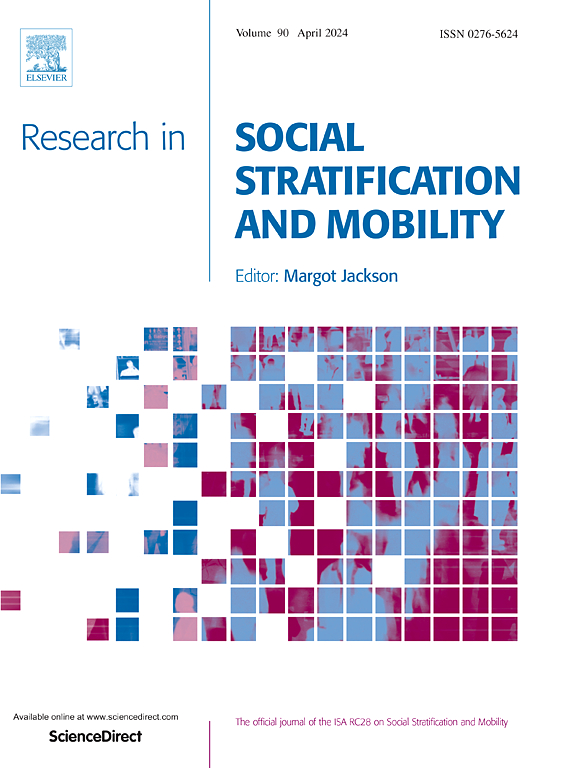平等的教育资格但不平等的劳动力市场结果:50年来职业地位的性别差异及其机制的探索
IF 2.7
1区 社会学
Q1 SOCIOLOGY
引用次数: 0
摘要
瑞士的教育扩张相对缓慢但仍在继续,加上瑞士劳动力市场上持续存在的性别差异,为调查过去50年来男女在职业地位方面的教育回报如何演变提供了一个独特的背景。利用大规模行政普查数据(1970年、1980年、1990年、2000年)和年度结构调查(2011-2020年),分析了伪出生队列(1920-1994年)在两个职业阶段(25-30岁和45-50岁)的社会变化。研究了两个问题:(1)具有相似教育程度的男性和女性之间的职业地位不平等如何随着时间的推移而变化?(2)哪些机制(如兼职工作、育儿责任和部门分配)解释了这些性别差异,它们的影响是如何变化的?研究结果显示,尽管在较年轻的人群中,尤其是在职业生涯的早期阶段,职业地位上的原始性别差距已经缩小,但在考虑到关键机制时,显著的差距仍然存在。布林德-瓦哈卡的分解表明,兼职工作和劳动力市场隔离继续产生性别惩罚。结果强调,即使在最近的队列中,妇女的受教育程度超过了男子,但就其职业地位而言,结构性因素继续限制妇女充分接受教育。本文章由计算机程序翻译,如有差异,请以英文原文为准。
Equal educational qualifications but unequal labor market outcomes: An exploration of gender disparities in occupational status and their mechanisms, over five decades
Switzerland’s comparatively slow but ongoing educational expansion, alongside the persistent gender disparities in the Swiss labor market, offers a unique context in which to investigate how returns to education, as regards occupational status, have evolved for men and women over the last 50 years. Drawing on large-scale administrative census data (1970, 1980, 1990, 2000) and annual structural surveys (2011–2020), social changes across pseudo-birth cohorts (1920–1994) at two career stages (ages 25–30 and 45–50) are analyzed. Two questions are investigated: (1) How have inequalities in occupational status between men and women with similar levels of educational attainment shifted over time? (2) Which mechanisms – such as part-time work, childcare responsibilities, and sector allocation – explain these gender differences, and how have their impacts changed? The findings reveal that although raw gender gaps in occupational status have narrowed in younger cohorts – particularly at early career stages – significant disparities persist when accounting for key mechanisms. A Blinder-Oaxaca decomposition shows that part-time work and labor market segregation continue to produce gendered penalties. The results underscore that even as women’s educational attainment has surpassed that of men in recent cohorts, structural factors continue to limit full returns to education for women, in regard to their occupational status.
求助全文
通过发布文献求助,成功后即可免费获取论文全文。
去求助
来源期刊
CiteScore
7.80
自引率
6.00%
发文量
46
期刊介绍:
The study of social inequality is and has been one of the central preoccupations of social scientists. Research in Social Stratification and Mobility is dedicated to publishing the highest, most innovative research on issues of social inequality from a broad diversity of theoretical and methodological perspectives. The journal is also dedicated to cutting edge summaries of prior research and fruitful exchanges that will stimulate future research on issues of social inequality. The study of social inequality is and has been one of the central preoccupations of social scientists.

 求助内容:
求助内容: 应助结果提醒方式:
应助结果提醒方式:


